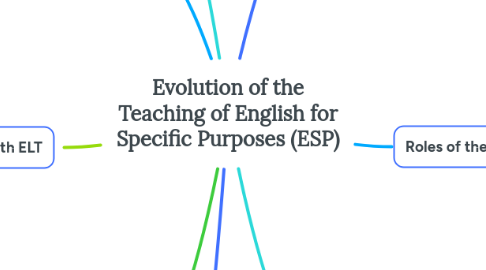
1. Characteristics Main:
1.1. Authentic Materials
1.2. Related Guidance with the purpose
1.3. self direction
2. according to the authors Dudley-Evans and St John (1998) this definition was modified
2.1. Fixes: Meets specific needs, uses disciplinary approach.
2.2. Variable aspects: It can be related to disciplines, different methods, aimed at adults, intermediate/advanced level.
3. It arises from three key trends:
3.1. Increased demand for English for professional purposes.
3.2. Changes in linguistics towards practical use of language.
3.3. Influence of educational psychology on student needs and interests.
4. ESP Types
4.1. It is divided into two main areas
4.1.1. English for Academic Purposes (EAP)
4.1.1.1. Courses before, during or after the experience.
4.1.1.2. includes science, technology, medicine, law, management and economics.
4.1.2. English for Occupational Purposes (EOP):
4.1.2.1. Focus on work or a specific discipline.
4.1.2.2. focuses on medical, business and vocational professions.
4.2. other types of ESP
4.2.1. EVP (English for Vocational Purposes)
4.2.1.1. Focuses on nursing, technology, or mechanics.
4.2.2. VESL (Vocational English as a Second Language - Vocational English as a Second Language)
4.2.2.1. focuses on vocational and technical settings.
5. Relationship with ELT
5.1. resources that both use for their continuous evolution
5.1.1. Educative technology
5.1.2. online resources
5.1.3. Authentic Materials
5.1.4. Content Adaptation
5.1.5. Teacher Training and Development
5.1.6. Evaluation and Feedback
